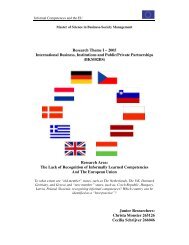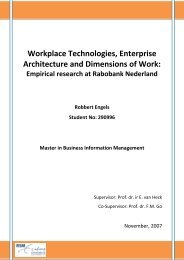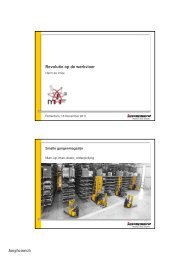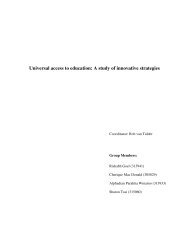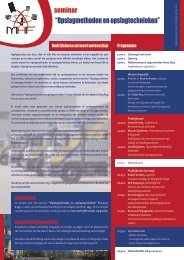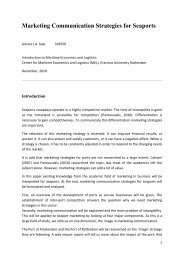here - ERIM - Erasmus Universiteit Rotterdam
here - ERIM - Erasmus Universiteit Rotterdam
here - ERIM - Erasmus Universiteit Rotterdam
Create successful ePaper yourself
Turn your PDF publications into a flip-book with our unique Google optimized e-Paper software.
A validation Study of House of Quality key performance indicators<br />
and suppliers to each other. Within the virtual environment consumers can compare different<br />
products, services, quality, prices and locations which will help them to make a more well-defined<br />
decision. In this case the virtual community acts as an organizing community to its members.<br />
Commercial orientation: some companies create their own communities; commercial communities.<br />
Companies provide valuable information about the company or/and her products to the members of<br />
the community. This information can lead to more appreciation of the company and her products by<br />
the members of the community. This makes the virtual community an attractive tool for companies.<br />
When discussing the concept of virtual communities an important aspect is to understand why<br />
people join a virtual community. What is their main purpose, why do they actively participate and<br />
why do they come back to the community every time? One of the reasons for participating in a<br />
virtual community can be either functional, such as information exchange (Wellman 1996) or from a<br />
hedonic aspect as the creation and consumption of a positive experience through interaction<br />
(Bargozzi and Dholakia, 2002). Interaction is recognized on three levels of communication; two-way<br />
non interactive communication; reactive communication and fully interactive communication (Jones,<br />
1997). Within the community information and knowledge can be seen as a valuable currency or as<br />
social resource (Hitz and Wellman 1997). Different form traditional communities, useful information<br />
and knowledge can be spread within the virtual community through so called “weak-ties” because<br />
members are relative strangers to each other. The virtual community can also be considered as an<br />
important reference group for its members, mostly in a secondary but sometimes also in a primary<br />
way (Constant et al, 1996).<br />
Another reason for participating in a virtual community is the social aspect provided by the<br />
community. It is stated by Heering (1996) that the freedom to express views and to receive social<br />
support are one of the main reasons for individuals to join and participate in a virtual community.<br />
Wellman (1997) defines virtual communities as social networks that use computer support as the<br />
basis of communication among members instead of face-to-face interaction. Furthermore, virtual<br />
communities make it possible to find individuals who are in the same situation and provide<br />
emotional support, social support, a sense of belonging and companionship (Wellman et al, 1999a).<br />
According to Hagel and Armstrong (1997) following types of needs can be distinguished why people<br />
participate in a virtual community:<br />
Interest; within the virtual community members come together because of a common<br />
interest. Members exchange information and share knowledge about this common interest<br />
by sharing resources or giving opinions and advices. Preece (2000) defines the virtual<br />
28




